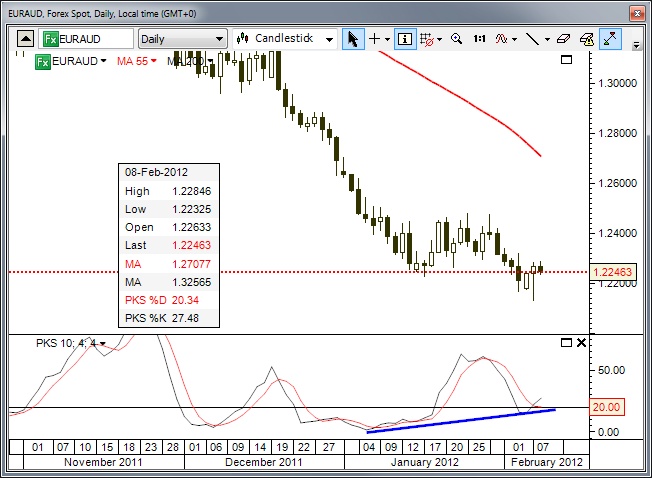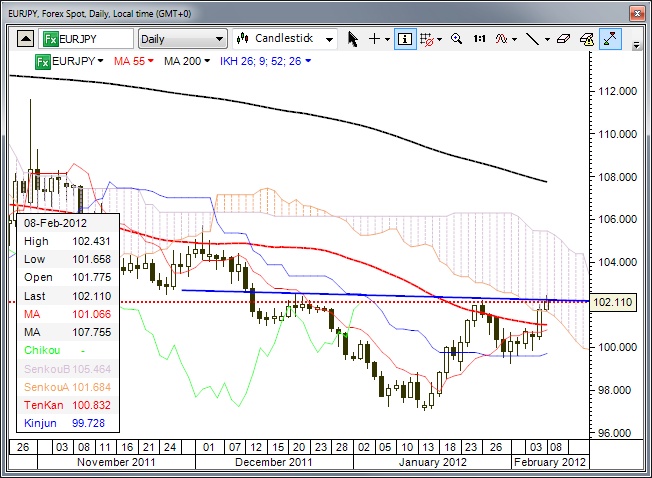The Euro not particularly concerned as the Greek politicians dawdle. NZD has reached a new almost 5-year high against its G10 peers as market tries to disprove notion that trees don’t grow to the sky.
Greek negotiations were working under the assumption that yesterday was to provide a deadline for the politicians to sign up for the Troika deal on offer, but now another day has passed and still no sign of a deal, even as the market tries very hard to squeeze the Euro shorts (a rather easy thing to do considering the lopsided positioning in this market.) Meetings are meant to begin in Athens as I am writing after last night saw further negotiations between the Greek PM Papademos and Troika representatives. Adding a sweetener to the deal yesterday was the news that the ECB would agree to swap its debt under the terms of the PSI deal, which involves a 70% haircut and would save the country a further EUR 11 billion. Another hitch in the situation is provided by the threat for elections, which may take place as soon as April and favour a change in political alignment, considering the sitting government’s profound unpopularity. So Troika elements are trying to extract promises from other leaders, particularly the more popular New Democracy party’s leader.
The question will be whether the market has baked a deal into the EUR/USD cake with EUR/USD trading above the old 1.3240 resistance or whether there is still a sufficiently large element of doubt on whether Greece signs on to an agreement. Certainly, if the market reacts Euro-positively to a Greek deal, there may be another couple of figures to squeeze out of the pair. Bears might prefer to wait for higher levels in the wake of a deal or for a dive back well below 1.3200 again before sticking their necks out. But EUR/USD may not be the most volatile pair here. Rather, the pro-risk currencies versus the Euro might come into focus in the event risk appetite sours. A Greece deal means less potential for massive new ECB money printing, so it is nominally Euro supportive, and it doesn’t necessarily bode well for risk appetite, as we will still have to worry about the yoke of austerity and the economic outlook. The EUR/AUD cross’ behaviour yesterday was particularly interesting in light of the recent news flow out of Australia and Europe
Chart: EUR/AUD
EUR/AUD saw an outside day bullish reversal yesterday with divergent momentum (a new low in prices, while momentum indicators don’t show a new low relative to the previous one). It is interesting that this happened despite the on-going uncertainty over Greece and just after the RBA decided not to cut rates after all. Could it finally be time for a bit of consolidation in the brutal EUR/AUD downtrend? The likely determining factor will be risk appetite from the Aussie side of the equation and the reaction to a Greek deal/no deal from the Euro side. Another factor here is positioning, with Aussie longs and Euro shorts rather stretched according to some speculative measures. The weekly US futures positioning report showed the second most Aussie longs (non-commercial futures longs) in the history of its weekly survey. And Euro shorts hit a huge new record a couple of weeks ago as well. Another factor here for the Aussie is China – see MISH discussing recent Chinese electricity production data that showed a steep drop in electricity usage in China in January. EUR/AUD" title="EUR/AUD" width="652" height="478">
EUR/AUD" title="EUR/AUD" width="652" height="478">
Bonds and JPY
JPY crosses have been flying higher of late as the global risk appetite has been very robust of late and as bonds have corrected considerably from their highs last week. This has so far kept USD/JPY out of intervention trouble, though significant upside resistance remains in place and that pair has reversed rather sharply off 1 week highs today. The technicals for EUR/JPY here are particularly interesting, as the pair is trying at key resistance even without the presence of a Greek deal. Specifically, the pair is poking at the neckline of the upside down head and shoulders formation and is trading back in the daily Ichimoku cloud. Is this a head fake or the real deal? The next day or two is likely to provide the answer.
Chart: EUR/JPY EUR/JPY" title="EUR/JPY" width="652" height="478">Looking ahead
EUR/JPY" title="EUR/JPY" width="652" height="478">Looking ahead
Bernanke did nothing yesterday to dispel the notion that the Fed meant what it said at the last FOMC meeting, but it is interesting that if we take an indicator like the December 2013 EuroDollar STIR, it has unwound much of the rally that took place since that January 25 meeting, (in the seven days before the meeting, it sold off about 14 ticks from its highest level, only to rally as much as 22 ticks after the meeting, with 16 of those ticks now having been erased as of this writing) This means there are those who are willing to bet that the Fed’s forecasts will prove wrong. Looking at Fed forecasts of the past, that doesn’t seem like such a crazy idea. And looking at interest rate differentials, the USD weakness is beginning to get a bit stretched.
Speaking of stretched, the kiwi has been the strongest currency among the G-10 of late and has scrabbled to a new, almost 5-year high against an evenly weighted basket of the rest of the G-10 currencies. New Zealand’s quarterly employment report is up tonight and could be the cause for some consolidation if it is a negative one. The currency has been overachieving remarkably relative to standard fundamental measures like interest rate differentials, which could be due to reserve managers or other investors playing the themes of commodities/low sovereign debt and risk assets remaining complacent in light of eternal liquidity promises from the largest central banks. It’s one of those themes that will last as long as it lasts, until the sudden realization sets in that it is unsustainable and over-crowded, at which time gains disappear far faster than they accumulated. As always – timing is the grand question.
Watch out for Chinese inflation data set for release tonight, as Asia may take this as a key indicator on the likelihood of further rounds of monetary easing or even stimulus from China.
- English (UK)
- English (India)
- English (Canada)
- English (Australia)
- English (South Africa)
- English (Philippines)
- English (Nigeria)
- Deutsch
- Español (España)
- Español (México)
- Français
- Italiano
- Nederlands
- Português (Portugal)
- Polski
- Português (Brasil)
- Русский
- Türkçe
- العربية
- Ελληνικά
- Svenska
- Suomi
- עברית
- 日本語
- 한국어
- 简体中文
- 繁體中文
- Bahasa Indonesia
- Bahasa Melayu
- ไทย
- Tiếng Việt
- हिंदी
Greece Deal Still on Hold. When Do We See the Turbo-Kiwi Reality Check?
Published 02/08/2012, 10:17 AM
Greece Deal Still on Hold. When Do We See the Turbo-Kiwi Reality Check?
Latest comments
Loading next article…
Install Our App
Risk Disclosure: Trading in financial instruments and/or cryptocurrencies involves high risks including the risk of losing some, or all, of your investment amount, and may not be suitable for all investors. Prices of cryptocurrencies are extremely volatile and may be affected by external factors such as financial, regulatory or political events. Trading on margin increases the financial risks.
Before deciding to trade in financial instrument or cryptocurrencies you should be fully informed of the risks and costs associated with trading the financial markets, carefully consider your investment objectives, level of experience, and risk appetite, and seek professional advice where needed.
Fusion Media would like to remind you that the data contained in this website is not necessarily real-time nor accurate. The data and prices on the website are not necessarily provided by any market or exchange, but may be provided by market makers, and so prices may not be accurate and may differ from the actual price at any given market, meaning prices are indicative and not appropriate for trading purposes. Fusion Media and any provider of the data contained in this website will not accept liability for any loss or damage as a result of your trading, or your reliance on the information contained within this website.
It is prohibited to use, store, reproduce, display, modify, transmit or distribute the data contained in this website without the explicit prior written permission of Fusion Media and/or the data provider. All intellectual property rights are reserved by the providers and/or the exchange providing the data contained in this website.
Fusion Media may be compensated by the advertisers that appear on the website, based on your interaction with the advertisements or advertisers.
Before deciding to trade in financial instrument or cryptocurrencies you should be fully informed of the risks and costs associated with trading the financial markets, carefully consider your investment objectives, level of experience, and risk appetite, and seek professional advice where needed.
Fusion Media would like to remind you that the data contained in this website is not necessarily real-time nor accurate. The data and prices on the website are not necessarily provided by any market or exchange, but may be provided by market makers, and so prices may not be accurate and may differ from the actual price at any given market, meaning prices are indicative and not appropriate for trading purposes. Fusion Media and any provider of the data contained in this website will not accept liability for any loss or damage as a result of your trading, or your reliance on the information contained within this website.
It is prohibited to use, store, reproduce, display, modify, transmit or distribute the data contained in this website without the explicit prior written permission of Fusion Media and/or the data provider. All intellectual property rights are reserved by the providers and/or the exchange providing the data contained in this website.
Fusion Media may be compensated by the advertisers that appear on the website, based on your interaction with the advertisements or advertisers.
© 2007-2025 - Fusion Media Limited. All Rights Reserved.
